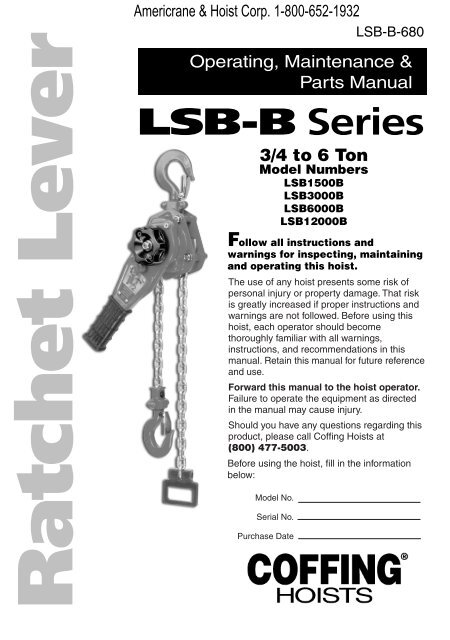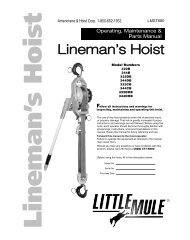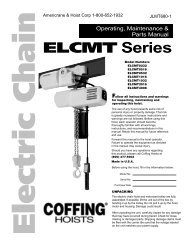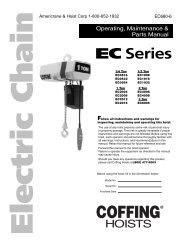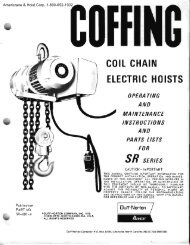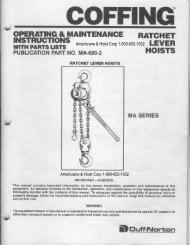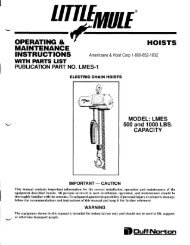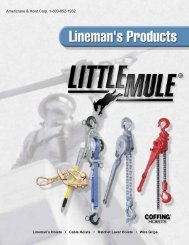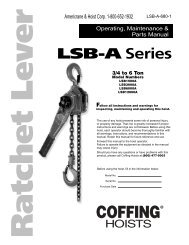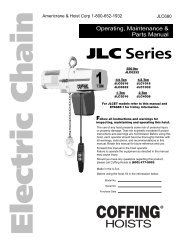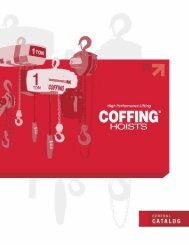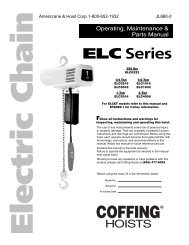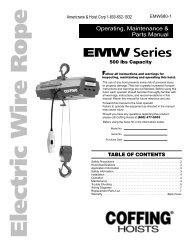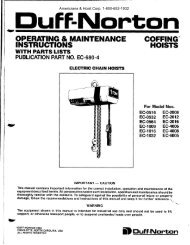LSB-B Series - Coffing Hoists, Coffing Hoist Parts
LSB-B Series - Coffing Hoists, Coffing Hoist Parts
LSB-B Series - Coffing Hoists, Coffing Hoist Parts
- No tags were found...
Create successful ePaper yourself
Turn your PDF publications into a flip-book with our unique Google optimized e-Paper software.
<strong>LSB</strong>B.qxd 7/11/2002 4:01 PM Page iRatchet LeverAmericrane & <strong>Hoist</strong> Corp. 1-800-652-1932Operating, Maintenance &<strong>Parts</strong> Manual3/4 to 6 TonModel Numbers<strong>LSB</strong>1500B<strong>LSB</strong>3000B<strong>LSB</strong>6000B<strong>LSB</strong>12000BFollow all instructions andwarnings for inspecting, maintainingand operating this hoist.The use of any hoist presents some risk ofpersonal injury or property damage. That riskis greatly increased if proper instructions andwarnings are not followed. Before using thishoist, each operator should becomethoroughly familiar with all warnings,instructions, and recommendations in thismanual. Retain this manual for future referenceand use.Forward this manual to the hoist operator.Failure to operate the equipment as directedin the manual may cause injury.Should you have any questions regarding thisproduct, please call <strong>Coffing</strong> <strong><strong>Hoist</strong>s</strong> at(800) 477-5003.Before using the hoist, fill in the informationbelow:Model No.Serial No.Purchase Date<strong>LSB</strong>-B-680<strong>LSB</strong>-B <strong>Series</strong>
<strong>LSB</strong>B.qxd 7/11/2002 4:02 PM Page 1Americrane & <strong>Hoist</strong> Corp. 1-800-652-1932SAFETY PRECAUTIONSEach <strong>Coffing</strong> <strong>LSB</strong>-B Manually Operated Lever Chain <strong>Hoist</strong> is built in accordance with thespecifications contained herein and at the time of manufacture complies with our interpretation ofapplicable sections of *American Society of Mechanical Engineers Code (ASME) B30.21 and the*American National Standards Institute ANSI/ASME HST-3M. *Copies of this Standard can beobtained from ASME Order Department, 22 Law Drive, Box 2300, Fairfield, NJ 07007-2300, U.S.A.Improper operation of a hoist can create a potentiallyhazardous situation which, if not avoided, couldresult in death or serious injury. To avoid such apotentially hazardous situation, the operator shall:1. NOT operate a malfunctioning or unusually performing hoist.2. NOT operate the hoist until you have thoroughly read and understood the manufacturer’sOperating and Maintenance Instructions or Manuals.3. NOT operate a hoist which has been modified without the manufacturer’s approval orcertification to be in conformity with applicable OSHA regulations.4. NOT lift or pull more than rated load of the hoist.5. NOT use damaged hoist or hoist that is NOT working properly.6. NOT use hoist with twisted, kinked, damaged, or worn load chain.7. NOT operate with any lever extension (cheater bar).8. NOT attempt to “free-chain” the hoist while a load is applied.9. NOT use the hoist to lift, support, or transport people.10. NOT lift loads over people and shall make sure all personnel remain clear of the supportedload.11. NOT attempt to lengthen the load chain or repair damaged load chain.12. Protect the hoist’s load chain from weld splatter or other damaging contaminants.13. NOT operate hoist when it is restricted from forming a straight line from hook to hook in thedirection of loading.14. NOT use load chain as a sling or wrap load chain around load.15. NOT apply the load to the tip of the hook or the hook latch.16. NOT apply load unless load chain is properly seated in the chain wheel(s) or sprocket(s).17. NOT apply load if bearing prevents equal loading on all load supporting chains.18. NOT operate beyond the limits of the load chain travel.19. NOT leave load supported by the hoist unattended unless specific precautions have beentaken.20. NOT allow the chain or hook to be used as an electrical or welding ground.21. NOT allow the chain or hook to be touched by a live welding electrode.22. NOT remove or obscure the warnings on the hoist.23. NOT operate a hoist which has NOT been securely attached to a suitable support.24. NOT operate a hoist unless load slings or other approved single attachments are properlysized and seated in the hook saddle.25. NOT lift loads that are NOT balanced and that the holding action is NOT secure, taking upslack carefully.26. NOT operate a hoist unless all persons are and remain clear of the supported load.27. Report malfunctions or unusual performances of a hoist, after it has been shut down untilrepaired.28. NOT operate a hoist which the safety placards or decals are missing or illegible.29. Be familiar with operating controls, procedures, and warnings.1
<strong>LSB</strong>B.qxd 7/11/2002 4:02 PM Page 2Americrane & <strong>Hoist</strong> Corp. 1-800-652-1932SAFETY PRECAUTIONS (Continued)Improper operation of a hoist can create a potentiallyhazardous situation which, if not avoided, couldresult in minor or moderate injury. To avoid such apotentially hazardous situation, the operator shall:1. Maintain a firm footing or be otherwise secured when operating the hoist.2. Check brake function by tensioning the hoist prior to each lift or pulling operation.3. Use hook latches. Latches are to retain slings, chains, etc. under slack conditions only.4. Make sure the hook latches are closed and not supporting any parts of the load.5. Make sure the load is free to move and will clear all obstructions.6. Avoid swinging the load or hook.7. Avoid lever “fly-back” by keeping a firm grip on the lever until operating stroke is completedand the lever is at rest.8. Inspect the hoist regularly, replace damaged or worn parts, and keep appropriate records ofmaintenance.9. Use the hoist manufacturer’s recommended parts when repairing the unit.10. Lubricate load chain per hoist manufacturer’s recommendations.11. NOT use the hoist load limiting or warning device to measure load.12. NOT operate except with manual power.13. NOT permit more than one operator to pull on lever at the same time. More than oneoperator is likely to cause hoist overload.14. NOT allow your attention to be diverted from operating the hoist.15. NOT allow the hoist to be subjected to sharp contact with other hoists, structures, orobjects through misuse.16. NOT adjust or repair the hoist unless qualified to perform such adjustments or repairs.17. NOT expose the unit to high temperatures in excess of 200°F.TABLE OF CONTENTSSafety Precautions...........................................................................................................1-2<strong>Hoist</strong> Specifications.............................................................................................................3Application Information........................................................................................................3Safety Information ...............................................................................................................4Operation ............................................................................................................................5Maintenance........................................................................................................................6Optional Overload Protection..............................................................................................7Trouble Shooting .................................................................................................................8Inspection & Maintenance Check List.................................................................................9Inspector’s Report.............................................................................................................10Lubrication Schedule ........................................................................................................10Replacement <strong>Parts</strong> List for .75 & 1.5 Ton Models........................................................11-12Replacement <strong>Parts</strong> List for 3 & 6 Ton Models..............................................................13-14Warranty .............................................................................................................Back Cover2
<strong>LSB</strong>B.qxd 7/11/2002 4:04 PM Page 3Americrane & <strong>Hoist</strong> Corp. 1-800-652-1932HOIST SPECIFICATIONS<strong>Coffing</strong> Lever <strong><strong>Hoist</strong>s</strong> are made of the best selected materials to provide long dependableservice for users. <strong>Coffing</strong> Lever <strong><strong>Hoist</strong>s</strong> are manufactured and processed through up to datestreamlined production facilities by skilled engineers under strict quality control. All leverhoists are tested per ASME B30.21 before leaving our factory. Refer to the back cover forCertification Statement.Table 1 - <strong>Hoist</strong> SpecificationsRated Std. Chain Minimum Pull on Length of Net TestCapacity Lift dia. Distance lever to operating Weight Load(tons) (ft) x falls Between lift full handle (lbs) (tons)Hooks (in) load (lbs) (in).75 5 ø5.6mmx1 11 7 /16 46 9 1 /4 12 1.1251.5 5 ø7.1mmx1 13 59 14 9 /16 21 2.253 5 ø9mmx1 16 15 /16 75 14 9 /16 35 4.56 5 ø9mmx2 22 3 /4 76 14 9 /16 67 9.0The design, materials and specifications are subject to changefor improvements without notice.LubricationGuideHandleSelectorLeverFigure 2 - Chain LubricationStop GripOperating HandleFigure 1 - Lever <strong>Hoist</strong>Figure 3 - Correcting Chain TwistAPPLICATION INFORMATION1. Inspect carefully for any damage that may occur during shipping. Check for loose,missing, or damaged parts.2. Lubricate the load chain along the whole length with machine oil (See Figure 2).3. Examine the load chain to ensure that there is no twist. When your lever hoist is a 6 tonthat lifts on 2 falls of load chains, twists can arise from the bottom hook being accidentallyturned over through the load chains (See Figure 3).4. Confirm that the supporting structure is strong enough to support the full rated capacityof the lever hoist with a generous factor of safety.3
<strong>LSB</strong>B.qxd 7/11/2002 4:06 PM Page 4Americrane & <strong>Hoist</strong> Corp. 1-800-652-1932SAFETY INFORMATION1. Keep the load within the rated capacity marked on the hoist’s lever. An excess load maylead to an accident. The lever hoist is overloaded when the handle effort indicated in thestandard specifications is exceeded (See Table 1).2. Before operating, lift and lower the load about 4" and test the brake system. Ineffectivebraking may lead to an accident.3. Loads must be lifted as slowly as possible. Load swinging and abrupt shocks will imposeon the lever hoist excessive burdens that may more than double the weight of the load.4. Extreme temperatures will affect the durability of the lever hoist. In subzerotemperatures loads must be lifted and lowered very slowly and carefully.Figure 4 - Incorrect AttachmentFigure 5 - Correct Attachment5. When hooking, the load must be applied squarely to the center of the hook and thehook must not come loose during operation. NEVER USE THE HOOK DIRECTLY ON ALOAD (See Figure 4). Use the attachments as shown in Figure 5.Figures 6 through 9 show improper hooking methods, which may cause the hook toelongate or bend. These hooking methods may also obstruct the load chain flow to the loadsheave and prevent the lever hoist from operating properly.6. Never run the chain out too far. When the lever hoist is run out beyond the range of lift, adangerous excessive load will be imposed on the load chain, stop grip and gearing.7. The selector lever must be set to the “UP” position when the lever hoist is under a loadduring hoisting or pulling.8. Lifting a load with two lever hoists is not recommended. If the job is unavoidable, keep theload well within the total rated capacity of each lever hoist to avoid overloading one orboth of the hoists; lift with exceptional care while maintaining proper balance, angle andlifting speed.In applications similar to Figures 6 through 9, be sureto use the correct slings and attachments to ensuresafe operation and long life of the lever hoist.Figure 6Figure 7Figure 8 Figure 94
<strong>LSB</strong>B.qxd 7/11/2002 4:06 PM Page 5Americrane & <strong>Hoist</strong> Corp. 1-800-652-19329. Do not throw or drop the lever hoist from high places; do not drag the lever hoist intransportation. Doing so may cause damage that may lead to an accident.10. Never leave or store the lever hoist with the brake system locked. Loosen the brakesystem by operating the lever hoist as if lowering a load.11. Always service and repair the lever hoist after use. Thoroughly clean the dust or if used inthe rain, wipe off the dirt and moisture and lubricate the lever hoist to prevent rust.12. Inspect the hooks and load chain for bends and any other types of defects. Also checkto see if the hooks rotate. If any defect is found, replace the defective component beforeusing the lever hoist again.OPERATIONHOISTING (PULLING) AND LOWERING (RELEASING) (Figure 1)Do not forget to lubricate the load chain, rotationsection of the bottom hook and the chain guides.1. <strong>Hoist</strong>ing (Pulling)Set the selector lever to the “UP” position. Take up the slacked load chain by turning theguide handle clockwise. Next, manipulate the operating handle clockwise.2. Lowering (Releasing)Set the selector lever to the “DOWN” position. Manipulate the operating handlecounterclockwise. When there is no load on the lever hoist, the load chain can be slackedby turning the guide handle counterclockwise.FREE-CHAINING (Figure 1)This operation is for making quick large adjustments of the load chain length without load.Set the selector lever to the “N” position and pull the load chain out in the desired direction.Free-chaining will not be possible during the following conditions:1. When the lever hoist is under a load.2. When the guide handle is in contact with something and not rotating freely.3. When the brake has locked from a large or abrupt load:Turn the guide handle 45° counterclockwise to unlockthe brake.4. When the brake is locked:The brake can be unlocked by setting the selector lever to the “DOWN” position andmanipulating the operating handle counterclockwise.RESETTING (Figure 1)The lever hoist will automatically change from the free-chaining condition to the brakelocked condition when a load is applied. Apply the load with one of the following twomethods:a. Turn the guide handle clockwise until the brake locks from the force of the load.b. Pull firmly on the stop grip until the brake locks from the force of the load (See Photo 1).Next, turn the selector lever to the “UP” position and hoist or pull by manipulating theoperating handle.5
<strong>LSB</strong>B.qxd 7/11/2002 4:07 PM Page 6Americrane & <strong>Hoist</strong> Corp. 1-800-652-1932MAINTENANCEThe lever hoist is designed and made to withstand heavy-duty materials handlingoperations, but wear and damage are unavoidable after a long period of use and dependingon the place and method of use. This is why we suggest that your company or workshopadapt a periodic inspection program for the lever hoist.1. Never leave the lever hoist in a damp environment or damp weather such as rain. Alwaysstore the lever hoist in a dry airy area.2. Proper lubrication will help lengthen the life of the lever hoist. Before storing, check to seeif the lever hoist is well lubricated. Be especially sure that the moving parts such as gearsand bearings are well lubricated.LOAD CHAINLoad chains worn-out or elongated beyond the permissible dimensions must be replaced atonce. Replace the entire load chain immediately even if one link of the load chain isextensively worn-out, elongated or damaged.HOOKSPhoto 1 - Slack Chain Take-UpIf the hook opening is elongated beyond the permissible dimension, the hook isdangerously deformed and must be replaced at once. No deformation of the hook shouldarise when the lever hoist is used and maintained properly.Figure 10 - Chain Inspection<strong>Hoist</strong>Capacity Diameter Standard Limit(tons) (ømm) (in.) (in.).75 5.6 6.732 6.8661.5 7.1 8.346 8.5113 & 6 9 10.709 10.9236
<strong>LSB</strong>B.qxd 7/11/2002 4:09 PM Page 7Americrane & <strong>Hoist</strong> Corp. 1-800-652-1932<strong>Hoist</strong>“C” DimensionCapacity Standard Size Limit(tons) (in.) (in.).75 1 3 /16 1 5 /161.5 1 13 /32 1 9 /163 1 21 /32 1 13 /166 2 3 /64 2 1 /4Figure 11 - HookInspectionNOTE: Limit *C (in.) are the maximum permissible dimensions ofthe hooks, which are about 10% wider than the standard hookopenings.OPTIONAL OVERLOAD PROTECTIONA standard <strong>LSB</strong>-B Lever <strong>Hoist</strong> can be converted to a unit with the overload protection byreplacing Reference No. 14 (See Figures 15 & 16) with Reference No. 80 (See Figure 12).Refer to chart below for the appropriate load limiter for your capacity hoists.Figure 12 -OverloadProtectionDevice80110Ref. .75 Ton 1.5 Ton 3 Ton 6 TonNo. Description Part No. Part No. Part No. Part No. Qty80 Overload IRB5080U KRB5080U NRB5080U QRB5080U 1Protection DeviceThe load limiter may require adjustment when it slips at or below rated load. Please refer tochart below for the correct torque setting for the load limiter. Only adjust the load limiter byReference No. 110. If the load limiter cannot be corrected by adjusting the torque setting orif any of the parts are damaged then the load limiter must be replaced. A special tool isrequired to adjust Item 110 properly (Contact Factory).Table 2 - Torque Range for Item 110<strong>Hoist</strong>Model7Torque Range(foot-lbs)<strong>LSB</strong>1500B 28 - 32<strong>LSB</strong>3000B 59 - 66<strong>LSB</strong>6000B 77 - 85<strong>LSB</strong>12000B 77 - 85NOTE: Excessive torque will damage the load limiterand could cause equipment damage or personalinjury.
<strong>LSB</strong>B.qxd 7/11/2002 4:09 PM Page 8Americrane & <strong>Hoist</strong> Corp. 1-800-652-1932TROUBLE SHOOTING––– Probable Cause ––– ––– Remedy–––Slip caused by ineffective braking.1. Worn-out friction discs.2. Excessive oil on the braking surface.3. Incorrect assembly of the brake system.1. Replace with new friction discs.2. Disassemble and clean.3. Assemble correctly. (See Figures 15 & 16)Load dropped while lowering.1. Damaged friction discs.2. Foreign matters in the braking system.1. Replace with new ones.2. Disassemble and clean.Jammed operating handle.Over-tightening of the brake.Operate the lever hoist as if lowering a load.Noises during hoisting and lowering operation.Wear or deformation of the load chain and load sheave.Replace with new parts.Operating handle becomes difficult to operate during lifting or lowering operation.1. Over-hoisting or over-lowering.2. Twist in the load chain causing it to get caught betweenload sheave and load chain guide.1. Operate the hoist in opposite direction.2. Operate the hoist in opposite direction and remove thetwist from the load chain.NOTE: Refer to Figures 15 & 16 for parts lists.8
<strong>LSB</strong>B.qxd 7/11/2002 4:09 PM Page 9Americrane & <strong>Hoist</strong> Corp. 1-800-652-1932INSPECTION AND MAINTENANCE CHECK LISTLEVER OPERATED CHAIN HOISTType of <strong>Hoist</strong>LocationManufacturerCapacity (Tons)Original Installation DateManufacturer’s Serial No.Item Frequency of Inspection Possible Deficiencies OK ActionReq’dFrequent PeriodicDaily Monthly 1-12 Mo.Load Chain * * * Inadequate lubrication, excessive wear or stretch, cracked,damaged or twisted links, corrosion or foreign substanceHooks * * * Excessive throat opening, bent or twisted more than 10°,damaged hook latch, wear, chemical damage, cracksHook Retainers * * * Worn or damaged nuts, pins, washers, collars used to securehook in load block or housingRatchet * Wear, cracks, broken teethHandle Pawl * Wear, cracks or binding& Load PawlPawl Springs * Breaks, corrosion, loss of tensionRetaining Rings * Missing or loss of retentionPawl Stud * Excessive wear, pawl retention, loosenessSheave, Pinion * Distortion, cracks, excessive wear, damaged threads, buildShaft, Chainup of foreign substancesAttachmentsGearing * Inadequate lubrication, distortion, cracks, worn or broken teethBearings, Shafts * Inadequate lubrication, distortion, cracks, excessive wearHousing, Load * Cracks, distortion, loose bolts, nuts or rivets. Internal build upBlock, Outrigger,of foreign substancesHook SwivelsNuts, Bolts, * Looseness, stripped or damaged threadsRivetsSupporting * Damage or wear which restricts ability to supportStructureimposed loadsCapacity Plate * Missing, damaged or illegible& DecalsNOTE: Refer to Maintenance and Inspection Sections of the <strong>Hoist</strong>-Maintenance Manual for further details.FREQUENCY OF INSPECTIONFrequent — Indicates items requiring inspection daily to monthly. Daily inspections may be performed by the operatorif properly designated.Periodic — Indicates items requiring inspection monthly to yearly. Inspections to be performed by or under thedirection of a properly designated person. The exact period of inspection will depend on frequency andtype of usage. Determination of this period will be based on the user’s experience. It is recommended thatthe user begin with a monthly inspection and extend the periods to quarterly, semi-annually or annuallybased on user’s monthly experience.Figure 13A — Recommended Inspection and Maintenance Check ListNOTE: This inspection and maintenance check list is in accordance with our interpretation ofthe requirements of the Safety Standard for Lever <strong><strong>Hoist</strong>s</strong> ASME B30.21. It is, however, theultimate responsibility of the employer/user to interpret and adhere to the applicablerequirements of this safety standard.9
<strong>LSB</strong>B.qxd 7/11/2002 4:09 PM Page 10Americrane & <strong>Hoist</strong> Corp. 1-800-652-1932ITEMINSPECTOR’S REPORTREMARKS (LIST DEFICIENCIES AND RECOMMENDED ACTION)Inspector’s DateSignature Inspected Approved by DateFigure 13B — Recommended Inspector’s ReportRECOMMENDED LUBRICATION SCHEDULE*COFFING LEVER OPERATED CHAIN HOISTFIGURE COMPONENT TYPE OF LUBRICANT TYPE OF SERVICE ANDNUMBERSFREQUENCY OF LUBRICATIONHEAVY NORMAL INFREQUENTSee Figures Load Chain SAE 20-30 machine oil Daily Weekly Monthly15 & 16See Figures Load Pawl Shaft, Multi-purpose Lithium At periodic inspection15 & 16 Pinion Shaft, Gear & base bearing grease (see Figure 13A)Bearings, Pinion &Gear TeethSee Figures Bottom Block Shaft,15 & 16 Bearing & Hook SwivelSAE 20-30 machine oilMonthly Yearly Yearly(*) This lubrication schedule is based on a hoist operating in normal environmentalconditions. <strong><strong>Hoist</strong>s</strong> operating in adverse atmospheres containing excessive heat,corrosive fumes or vapors, abrasive dust, etc., should be lubricated more frequently.CAUTION - DO NOT LUBRICATE BRAKE AREA OF HOIST.Figure 14 — Recommended Lubrication Schedule10
<strong>LSB</strong>B.qxd 7/11/2002 4:12 PM Page 11Americrane & <strong>Hoist</strong> Corp. 1-800-652-1932Figure 15 - .75 & 1.5 Ton Models32192222612523312941013296 285117*3830 83020262414 153431213236373318162739173511
<strong>LSB</strong>B.qxd 7/11/2002 4:12 PM Page 12Americrane & <strong>Hoist</strong> Corp. 1-800-652-1932Ref. .75 Ton 1.5 TonNo. Description Part No. Part No. Qty1 Pinion Shaft IRB5001 KRB5001 12 Pinion with Pinion Gear IRB4002T KRB4002T 23 Load Gear IRB4004 KRB5004 14 Load Sheave IRB5005 KRB5005 1†5 Load Chain T56 V71 16 Pawl IRB5007 KRB5007 27 Disc Hub IRB5008 KRB5008 18 Ratchet Wheel IRB5009 KRB5009 19 Chain Guide IRB5012 KRB5012 210 Stripper IRB5015 KRB5015 111 Stop Grip IRB40062T KRB40062T 112 Gear Side Plate IRB5018T KRB5018T 113 Handle Side Plate IRB5020U KRB5020U 114 Disc Nut IRB5023 KRB5023 115 Operating Handle IRB5024T KRB5024T 116 Spring Shaft IRB4030 IRB3030 117 Shaft Base IRB4031 IRB3031 118 Handle Pawl GRB5032 KRB5032 119 Gear Cover IRB5037 KRB5037 120 Ratchet Cover Assembly IRB5040 KRB5040 121 Guide Handle IRB5042 IRB5042 122 Top Hook Assembly IRB5048U KRB5048U 123 Yoke Pin IRB5051 KRB5051 124 Bottom Hook Assembly IRB5053U KRB5053U 125 Collar for Pinion Shaft IRB5059 IRB5059 126 Hook Latch Assembly GRB5074T KRB5074T 227 Change Over Spring IRB4101 IRB3116 128 E-Ring SRE8 SRE9 229 Pawl Spring IRB5104 KRB5104 230 Brake Lining IRB5105 KRB5105 231 Free-Chaining Spring IRB5106 KRB5106 132 Spring Nut HSN1M8 HSN1M8 833 Spring Nut HSN1M6 HSN1M8 234 Upset Bolt CUSM6X10S2 CUSM8X12S2 135 Name Plate IRB5114DN KRB5114DN 136 Plain Washer PWM8M PWM8M 137 Nylon Nut HNN1M8 HNN1M8 138* Chain Fastening Bolt IRB4124T KHH5048T 139 Cross Recessed Head Bolt CBM5X25B3 CBM5X25B3 2†Specify the lift when placing an order for Load Chain.* Includes Nut and Bolt.NOTE: When ordering spare parts please have Model, Capacity, Product Number andQuantity available.12
<strong>LSB</strong>B.qxd 7/11/2002 4:15 PM Page 13Americrane & <strong>Hoist</strong> Corp. 1-800-652-1932Figure 16 - 3 & 6 Ton Models3619212230*4230292322Used on 6 Ton Models312133394106 3257*42301134 834202414 153835 2144 25283640284537181631173943 414627 263024Used on 6 Ton Models13
<strong>LSB</strong>B.qxd 7/11/2002 4:15 PM Page 14Americrane & <strong>Hoist</strong> Corp. 1-800-652-1932Ref. 3 Ton 6 TonNo. Description Part No. Part No. Qty1 Pinion Shaft NRB5001 NRB5001 12 Pinion with Pinion Gear NRB5002T NRB5002T 23 Load Gear NRB5004 NRB5004 14 Load Sheave NRB5005 NRB5005 1†5 Load Chain V9 V9 16 Pawl KRB5007 KRB5007 27 Disc Hub KRB5008 KRB5008 18 Ratchet Wheel KRB5009 KRB5009 19 Chain Guide NRB5012 NRB5012 210 Stripper NRB5015 NRB5015 111 Stop Grip NRB40062T NRB40062T 112 Gear Side Plate NRB5018T NRB5018T 113 Handle Side Plate NRB5020U NRB5020U 114 Disc Nut KRB5023 KRB5023 115 Operating Handle KRB5024T KRB5024T 116 Spring Shaft IRB3030 IRB3030 117 Shaft Base IRB3031 IRB3031 118 Handle Pawl KRB5032 KRB5032 119 Gear Cover NRB5037 NRB5037 120 Ratchet Cover Assembly NRB5040 NRB5040 121 Guide Handle IRB5042 IRB5042 122 Top Hook Assembly NRB5048U QRB5048U 123 Yoke Pin NRB5051 NRB5051 124 Bottom Hook Assembly NRB5053U QRB5053U 125 Load Block Frame - QRB50533 226 Idle Sheave - QRB5055 127 Wheel Pin - QRB5056 128 Collar for Idle Sheave - HH4100083 229 Collar for Pinion Shaft NRB5059 NRB5059 130 Hook Latch Assembly KRB5074T PRB5074T 231 Change Over Spring IRB3116 IRB3116 132 E-Ring SRE9 SRE9 233 Pawl Spring NRB5104 NRB5104 234 Brake Lining KRB5105 KRB5105 235 Free-Chaining Spring NRB5106 NRB5106 136 Spring Nut HSN1M10 HSN1M10 837 Spring Nut HSN1M8 HSN1M8 238 Upset Bolt CUSM8X12S2 CUSM8X12S2 139 Name Plate NRB5114DN QRB5114DN 140 Plain Washer PWM8M PWM8M 141 Nylon Nut HNN1M8 HNN1M8 142* Chain Fastening Bolt NRB4124T NRB4124T 143 Cross Recessed Head Bolt CBM5X25B3 CBM5X25B3 244 Hexagonal Socket Head Bolt - CBM10X35 345 Spring Nut - HSNM10 346 Knock Pin - NP6X10 1†Specify the lift when placing an order for Load Chain.* Includes Nut and Bolt.NOTE: When ordering spare parts please have Model, Capacity, Product Number andQuantity available.14
<strong>LSB</strong>B.qxd 7/11/2002 4:16 PM Page 15Americrane & <strong>Hoist</strong> Corp. 1-800-652-1932High Performance LiftingWARRANTYEvery hoist is thoroughly inspected andperformance tested prior to shipment fromthe factory. If any properly installed,maintained and operated hoist as outlinedin the applicable accompanying <strong>Coffing</strong><strong><strong>Hoist</strong>s</strong> manual develops a performanceproblem due to defective materials orworkmanship as verified by <strong>Coffing</strong> <strong><strong>Hoist</strong>s</strong>,repair or replacement of the hoist will bemade to the original purchaser withoutcharge and the hoist will be returned,transportation prepaid. This warranty doesnot apply where deterioration is caused bynormal wear, abuse, improper orinadequate power supply, improperor inadequate maintenance, eccentric orside loading, overloading, chemical orabrasive actions, excessive heat,unauthorized modifications or repairs, oruse of non-<strong>Coffing</strong> repair parts. EXCEPTAS STATED HEREIN, COFFING HOISTSMAKES NO OTHER WARRANTIES,EXPRESS OR IMPLIED, INCLUDINGWARRANTIES OF MERCHANTABILITYAND FITNESS FOR A PARTICULARPURPOSE.Overloading and Improper Use Can Result In InjuryTO AVOID INJURY:• Do not exceed working load limit, load rating, or capacity.• Do not use equipment to lift people or loads over people.• Use only alloy chain and attachments for overhead lifting.• Read and follow all instructions.Certification StatementThis is to certify that the accompanying <strong>Coffing</strong> <strong>Hoist</strong>(s) has (have) been tested at125% of rated capacity and inspected in accordance with ASME/ANSI B30.16or B30.21. Do not exceed rated capacity stated on the hoist. Refer to manual foroperating instructions and forward manual to operator.<strong>Coffing</strong> <strong><strong>Hoist</strong>s</strong> • Country Club Road • P.O. Box 779 • Wadesboro, North Carolina 28170 USATel: 800.477.5003 • Fax: 800.374.6853 • 704.694.6829www.coffinghoists.com<strong>LSB</strong>-B-680©2002 <strong>Coffing</strong> <strong><strong>Hoist</strong>s</strong>


